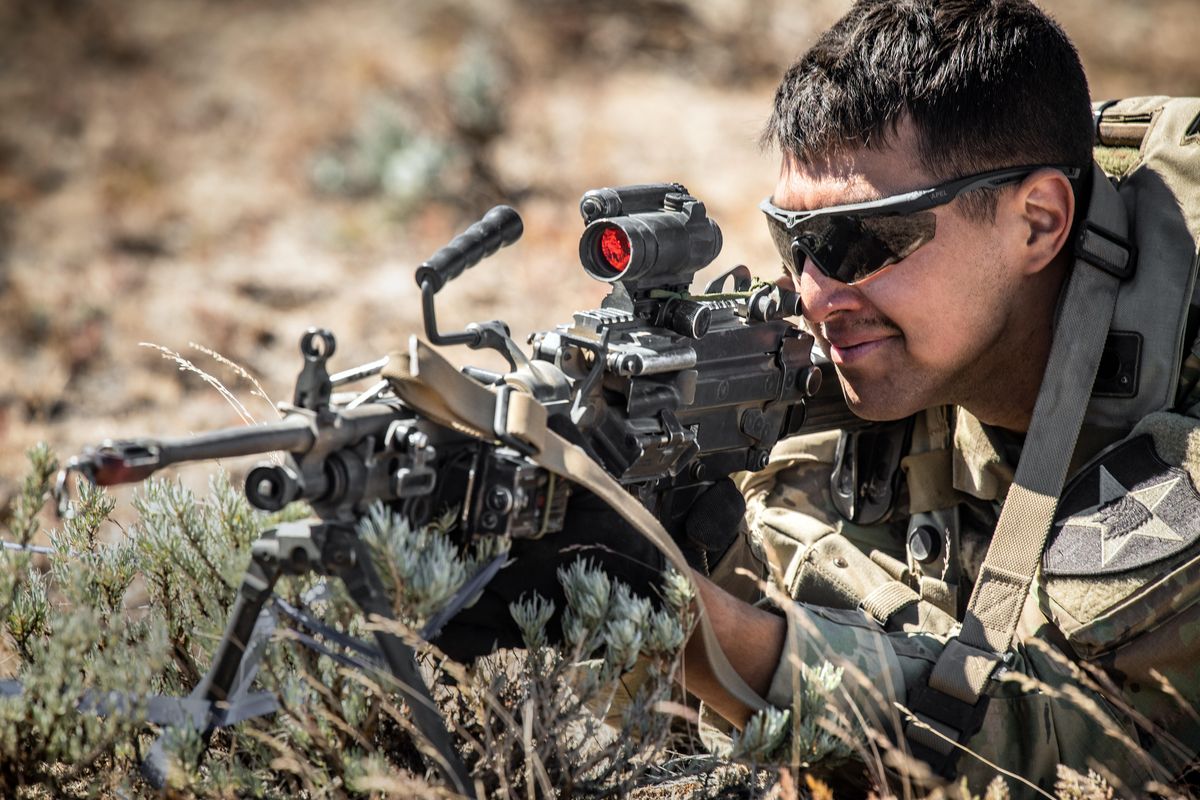Guardsmen training in Yakima preparing for 2021 deployment to Poland

YAKIMA TRAINING CENTER – The rugged scrubland between Yakima and Ellensburg looks nothing like Poland, but that’s not the point.
What matters is that the 81st Stryker Brigade Combat Team of the Washington Army National Guard is preparing for whatever comes its way, including a yearlong deployment in Eastern Europe in two years.
“We’re prepared for anything,” said Maj. Nicholas Stuart, executive officer of a Stryker battalion that on Tuesday morning was conducting field maneuvers.
Heavily laden infantry moved in squads toward designated targets, preparing to engage the enemy amid heat, dirt and dust. Stryker armored fighting vehicles were ready to move out and scout, while Stuart’s command center was coordinating the whole operation.
Elsewhere on the sprawling Yakima Training Center, other Stryker battalions were in action, while artillery units were firing live 155mm shells with uncanny accuracy.

Most of the brigade’s 3,800 soldiers are from Washington, with a few from Oregon and California. In a few days, they’ll pack up, move a few miles and do it again, perfecting the Stryker goal of moving fast and hitting hard.
The three-week-long exercise is part of the Army’s eXportable Combat Training Capability, or XCTC, program.
It’s a building block of sorts, according to Stuart, a former Spokane resident who now lives in Kent, Washington, and works full time for the National Guard.
“This is our first chance to put the entire brigade together,” said Stuart, whose battalion will join other units in the brigade next year at the Fort Irwin National Training Center in the Mojave Desert of California.
According to Stuart, “That will be a dress rehearsal where we really put the wartime experience together” in preparation for deployment to Poland in 2021 to support Enhanced Forward Presence.
“We are preparing for Poland,” said Stuart, who expects to work with NATO allies from much of Europe. Then he hedged, noting that the 81st undertook two tours in Iraq.
“The world changes rapidly, and our mindset is to maintain a mindset of flexibility,” Stuart said.
That appears to be the motto of the 81st, which can move fast but also strike hard. Its namesake Stryker IFV carries light armament (usually an M2 .50-caliber machine gun or Mk-19 40mm grenade launcher), but can hit 50 mph in open country.
“But they restrict us to 25 on the base,” lamented Sgt. Jose Soto, of Yakima, who clearly would like to go faster.
The Stryker battalions serve as the eyes of the Army, performing reconnaissance and making sure the ground is clear for a planned advance. As such, the Stryker was built with less armor than tracked vehicles. However, some training exercises have shown Stryker brigades to hold their own against heavier-armed vehicles.
The Strykers can carry up to nine passengers, but Tuesday the infantry moved on foot in squads of a dozen or so, prepared to engage the enemy – other American soldiers acting as the opposing force.
The soldiers used blank ammunition and laser transmitters mounted to their rifles, so sophisticated they won’t register a “hit” if a machine gun round strikes a Humvee, but will do so if the ordnance is heavier.
Even more realistically, the lasers’ range can be adjusted to match the weapon.
In this exercise, infantry and Strykers used live fire only against targets. “It’s how we’re simulating warfare,” Stuart said.
However, casualties are a way of life in the field. Taylor Stich, a student at Eastern Washington University who joined the National Guard partly to pay for college, has stayed busy as a medic.
“We’ve had a few cases of heatstroke,” Stich said. “Every day we have patients in the battalion aid station, and we give them what they need and treat them the best we can.”
A few miles away, Charlie Battery was perfecting its craft. The M777 Howitzer can throw a 155mm shell up to 18 miles – roughly from Cheney to downtown Spokane – and come within 15 yards of the target.
Using live rounds, the crew worked with a forward observer and the fire direction center, with encrypted signals sent through a portable computer, as they engaged targets 3 to 5 miles away.
Repetition was the key.
“You have to get to fatigue and you build muscle memory,” said 1st Sgt. Adam Yoest. “When you’re competent and capable and reach that point of fatigue, that means you’re actually learning.”
A few feet away, infantryman Zak Gaskill, of Bremerton, was standing guard. Now in his fourth year in the Guard, he’ll graduate this month from Central Washington University.
Looking ahead, he noted his contract with the Guard will expire just before the deployment to Poland.
“But I will gladly deploy for that extra year to serve,” Gaskill said.